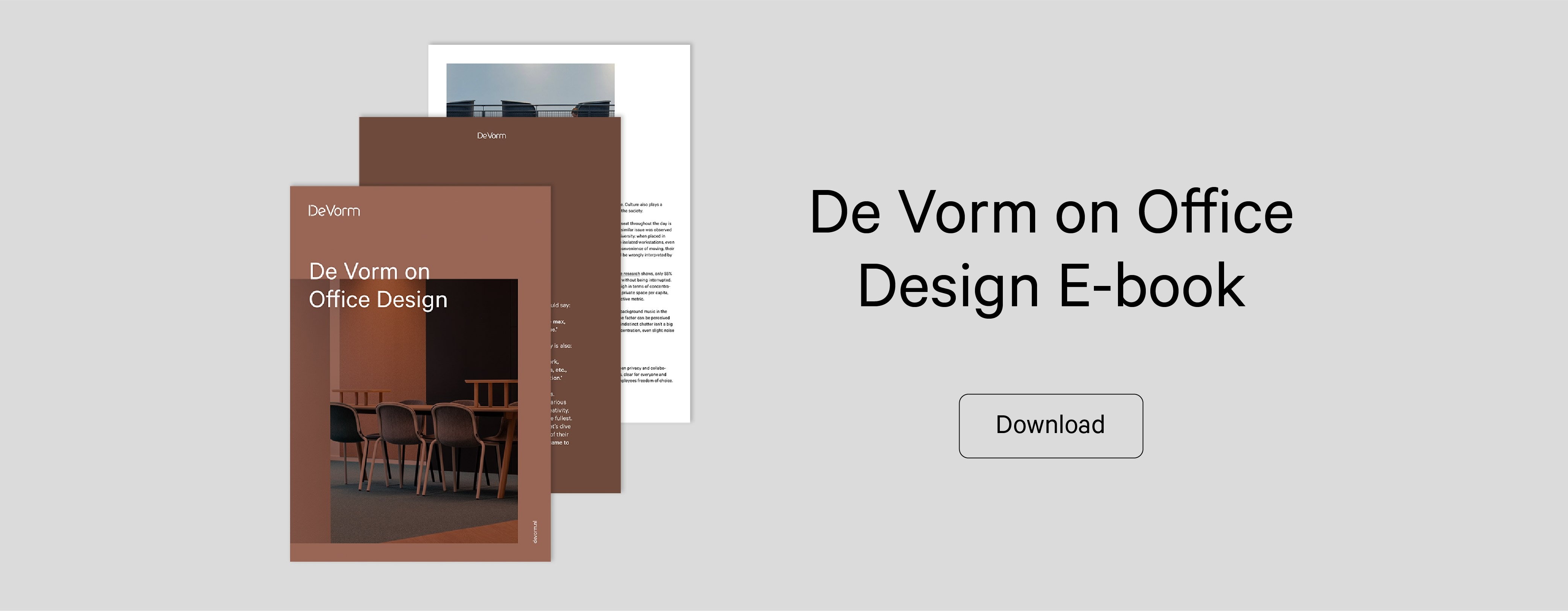Journal
De Vorm on Office Design
What is an office? If you would ask Michael Scott, he would say: “An office is a place to live life to the fullest, to the max, to.. An office is a place where dreams come true.” Although that could be true for some, the office officially is also: “A room or part of a building in which people work, especially sitting at tables with computers, phones, etc., usually as a part of a business or other organization.”
Also true for some, but still not quite cutting it for others. Simply because the office serves various purposes for various people. From being a physical location or a source of creativity, the office aims to meet the needs of its employees to the fullest. Thus, creating the ideal workplace can be a tall order. Let’s dive deeper into the place where people spend up to a third of their life and try to understand how the office as we know it came to be and how it is designed.
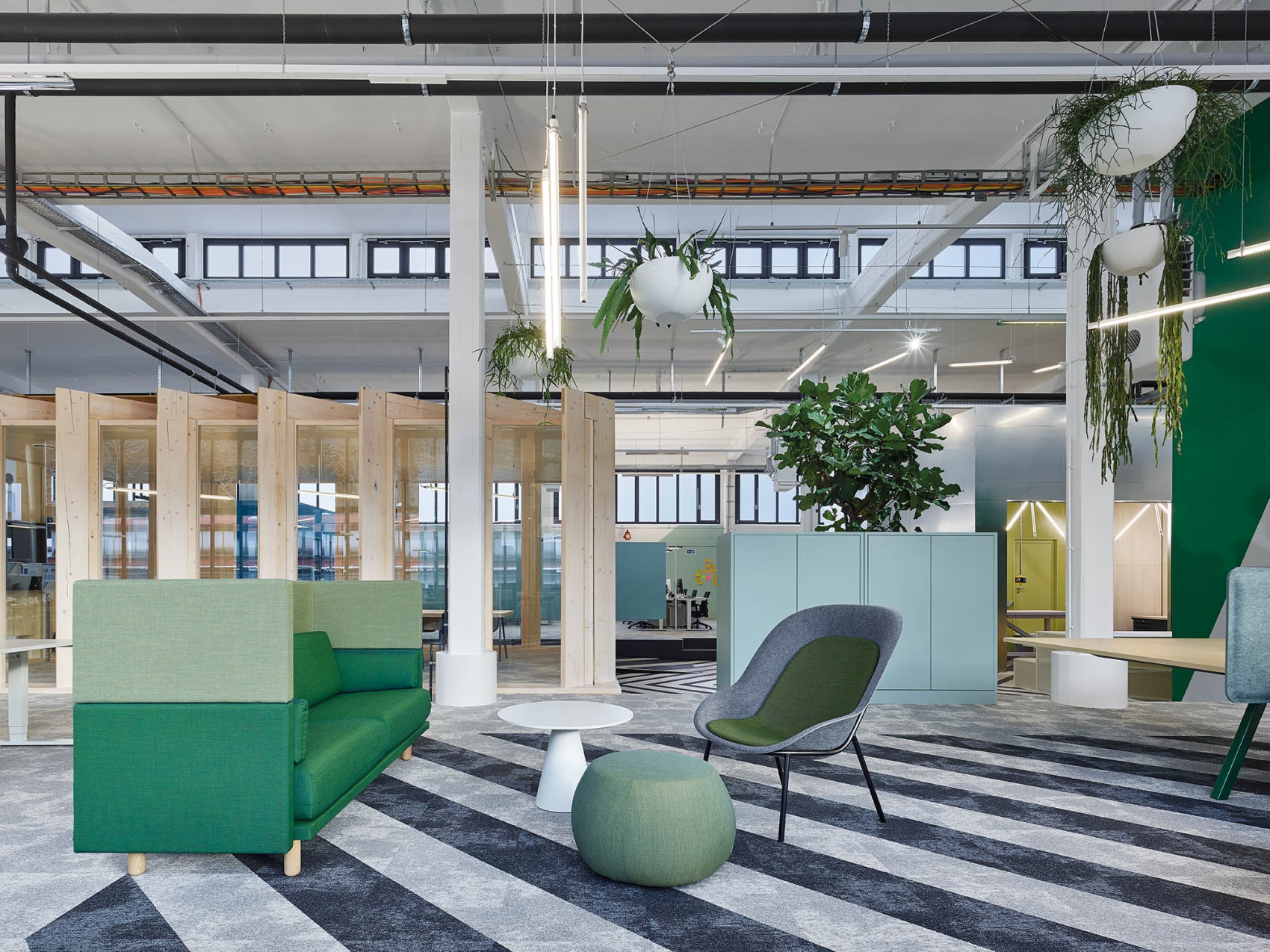
Contents: De Vorm on Office Design
This is what we will cover on this page. Click to jump to the section. You can also  this page as a e-book.
this page as a e-book.
- History of office design
- The first office
- The first open-plan office
- Say hello to the Burolandschaft
- Get into the Action Office
- The rise of the dreaded but successful cubicle
- Back to the open-plan office and the introduction of the virtual office
- The modern office feels like home
- Things to consider when designing a modern office
- How colour influences your staff
- Providing a safe work environment for a diverse workforce
- Extraverts at work
- Introverts at work
- Designing workspaces for introverts, extraverts and conscientious types
- Designing great breakout areas
- The future of workplace design
History of office design
Today, the office can exist anywhere, as long as there is WiFi, a seat and coffee. Remarkable really, when not that long ago offices resembled factories. Rows and rows of desks and no personal space supposedly because this maximized efficiency. In stark contrast, the focus in the office today is shifting towards the individual. Productivity and efficiency are still important but so is creativity and well being. But what is an office and where did the history of the office begin?
The first office
As soon as humans started to collaborate in larger groups, came the need to keep track of stuff. First invented by the Romans, not necessarily a specific building or place, but often the performance of administrative tasks. Offices in this form have existed throughout history. Until the 18th century, they were usually found in larger places like palaces or temples.
The 18th century saw the rise of large, complex organisations and the construction of the first purpose-built office spaces. The Old Admiralty, London, UK (or Ripley building) was the first one in 1726, still in use today by the Royal Navy.
Initially, office spaces were relatively modest buildings with a maximum of 10 stories. Later with the introduction of iron and steel higher buildings were possible, and with the invention of the elevator in 1852, the sky became the limit. Office buildings became a common sight and office design became an architectural discipline.
The first open-plan office
The first modern offices weren’t, well, very nice to work in. Designed to be more like a factory farm then anything else. They were based on the principles of Taylorism, by mechanical engineer Frank Taylor. He sought to maximise industrial efficiency. Human and social elements were certainly not a part of this equation.
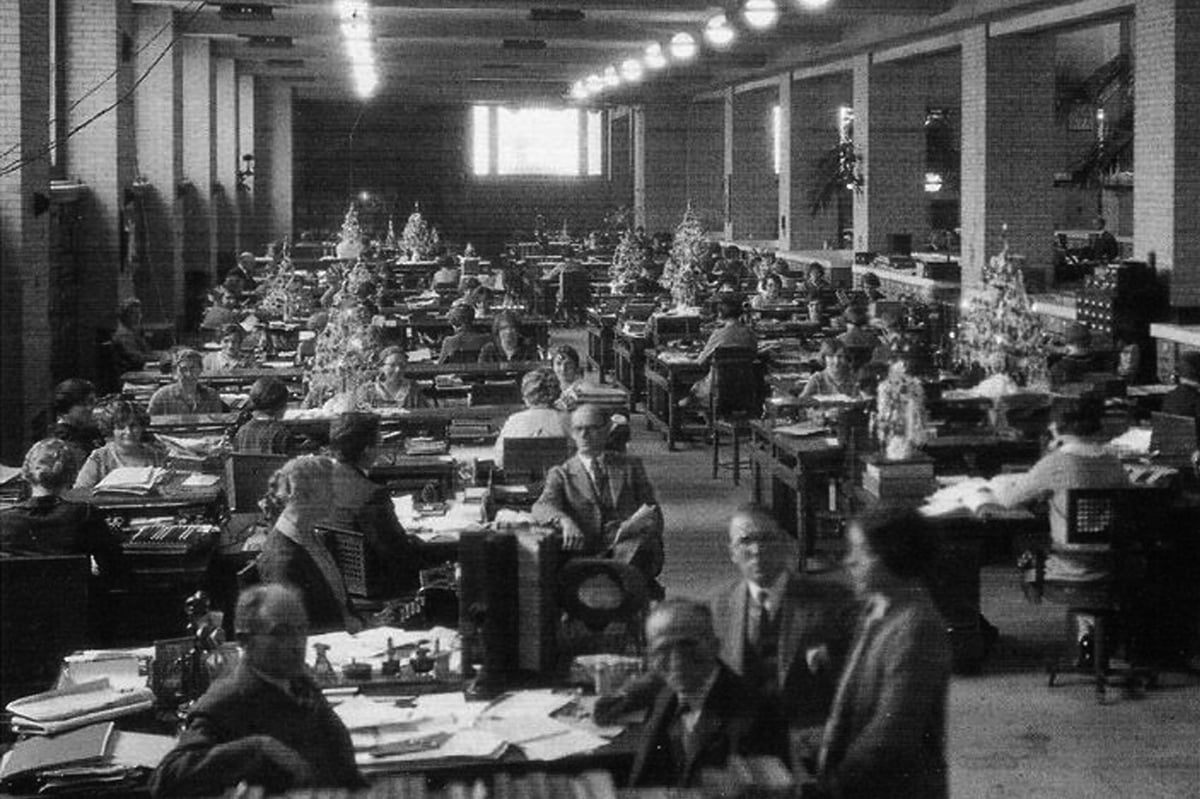 Inside the Larkin Administration Building
Inside the Larkin Administration Building
The first office built by Taylorist principles was the Larkin Administration Building. 1,800 workers processed 5,000 orders per day, the summum of efficiency in 1904. Just like in a factory, simple and repetitive tasks were delegated to clerks to create a constant workflow. They worked in a central open space. Now more desks and workers could be fitted in a room. Of course, senior management kept their own private offices.
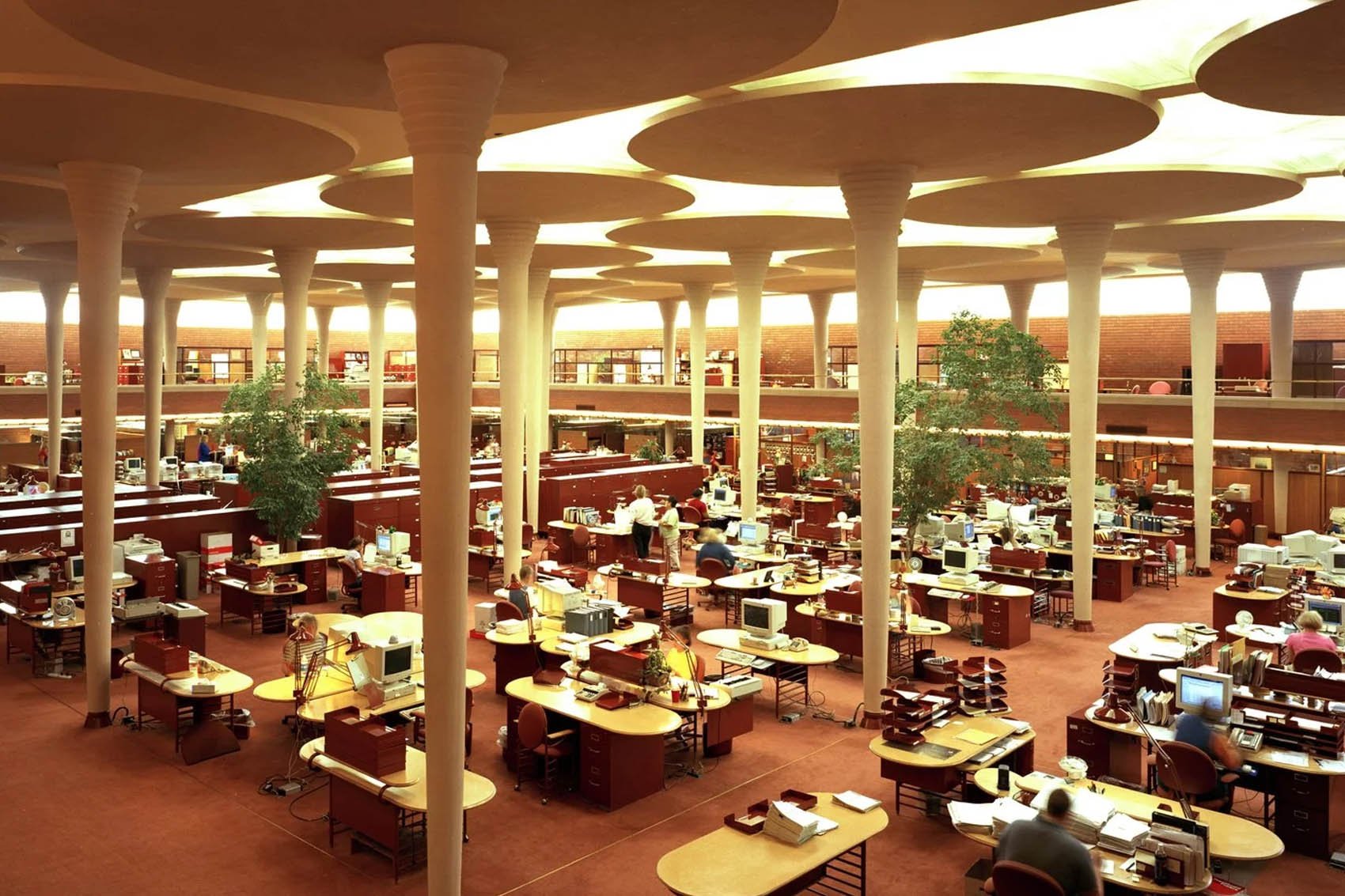 The Great Workroom in the Johnson Wax Building
The Great Workroom in the Johnson Wax Building
The next milestone in office design was reached in the 1930s. Frank Lloyd Wright designed the Johnson Wax Building and the Great Workroom really stood out. Still designed with Taylorist principles in mind to increase productivity, it also included new elements such as warm spaces, bright lights and cork ceilings. The latter was included “to absorb the sound rising from the heated rubber floor and blend it into a placid hum.”
Say hello to the Burolandschaft
The realisation that white-collar work is a different level to that of the factory blue-collar work slowly sank in. The early 1960s saw the rise of the German concept of Burolandschaft (office landscape). Incorporating workers’ needs, and encouraging human interaction, it was overall less rigid than the Taylorist system.
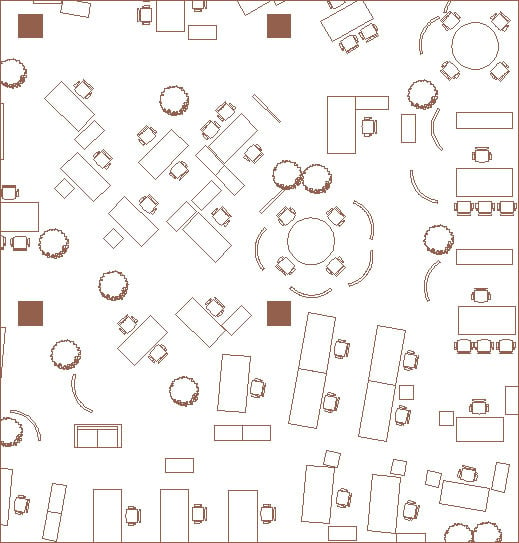
Example of Burolandschaft office plan
Teams became grouped together and the workplace also became a more social affair. Collaborations grew organically and staff from different levels began to sit and work together. Even plants became a regular site in offices around the world. It may seem like a slight change but compared to the Taylorist office that focused solely on efficiency, this was a huge shift in the office work concept. The Burolandschaft essentially laid the social foundations for modern office design.
Get into the Action Office
The Burolandschaft evolved into the Action Office by incorporating Action Furniture. According to designer Robert Propst, office work was mental work and the design of the office should help workers focus on their tasks. He suggested adapting the desks to this new office landscape to offer more privacy and mitigate noise.
However, the most influential driver for change at that time was the influx of women in the workplace. Women only wore dresses and that didn’t go well with the open desks of that time. That could have easily been solved by wearing trousers, but the spirit of the times was not ready. So the modesty board was introduced, a plywood section to cover the legs of the women in the office.
Action Office wasn’t a success, although the press was enthusiastic. The Saturday Evening Post cried, “Office workers of America, beware! The Action Office is coming! We are in real danger of being enabled to work at 100% efficiency.” Ultimately the managers and decision-makers didn’t go for it. It’s successor, the Action Office 2, however, was a huge success.
The rise of the dreaded but successful cubicle
The Action Office was meant to be flexible and give workers space to personalize their working environment. It resulted instead in companies using it to cram as many people into a small space and as cheaply as possible. The cubicle farm was born. Taylorism was back, although now it came wrapped in fabric.
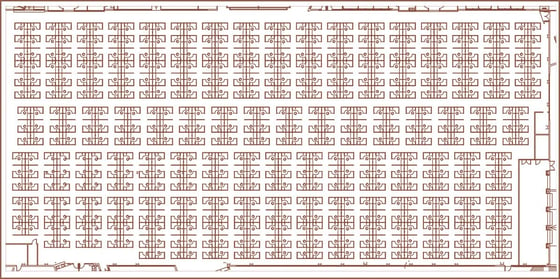
A typical cubicle office plan
During its most popular period, the cubicle was widely ridiculed. It did however, have a positive effect on productivity. Workers were isolated from noise and distraction. Yet they were also separated from colleagues and spontaneity. The movie Office Space shows the horrors of the classic cubicle farm perfectly.
Premiered in 1999 and together with the popular comics like Dilbert, you would expect the cubicle would start to die out. But the Action Office 2 total sales reached $5 billion in 2005. Much to the dislike of it’s inventor Robert Propst:
“Not all organisations are intelligent and progressive. Lots are run by crass people who can take the same kind of equipment and create hellholes. They make little bitty cubicles and stuff people in them. Barren, rat-hole places.”
Do you think that Robert saw Office Space?
Back to the open-plan office and the introduction of the virtual office
In the 1990’s the introduction of the internet shook up the office landscape. The new technology took office design back to 1900’s and the cubicles were torn down. Now workers could group together around a desk and watch the latest cat video online.
Internet also meant that the office could suddenly be anywhere. In a train, a coffee shop or at home. As long as there is an Internet connection, you could call any place your office. This new type of freedom also had a financial component. Companies no longer needed to facilitate all their workers all the time with a desk, a screen and a telephone. Saving room and money. These early ‘virtual offices’ made it hard for employees to feel at home or grounded. Even though working in a cubicle was terrible, at least it was your cubicle with your personal stuff.
At the turn of the century, the dot com companies set the trend for playful, casual offices where the spirit of the open-plan office bloomed again. This time with wilder colour schemes, playrooms and in-house coffee shops. The lines between work and free time, as well as between people and spaces began to blur.
The modern office feels like home
Nowadays, strict open-office plans or cubicle farms are no longer the popular choice. Flexibility is key, not only with furniture but also with people. One part of the day you can work at your desk in an open office. The other part of the day, you can work elsewhere in solitude and concentrate on an important task. In most modern offices people are able to work as they want to. Just like teams are getting more agile, the workplace is becoming more adaptable as well.
Whilst, bright colours are still in use, just as table tennis and foosball. If it's the homely feeling you want to create, then its advisable to use warm colours, soft seating and intimate lighting. Offering different kinds of work environments, such as a place to collaborate and a place to work in solitude. In the war for talent, the workplace becomes an important asset in order to attract and retain talents in a competitive global marketplace. A well-designed office where people like to work but also feel at home can make all the difference in recruitment.
Well-being at work is also becoming an important trend. Acoustics is getting a lot of attention lately, as it plays a big role in feeling well at work. Next to furniture and wall panels, plants also have great acoustic value. But our green friends offer more benefits, like fresh and clean air.
In short, that is how the office evolved from the open-factory farm office to the open homelike workplace. It continues to evolve creating many exciting opportunities for designers, architects and of course workers.
Things to consider when designing a modern office
Research shows that employees are distracted on average every 11 minutes. After an interruption, our brain needs 23 minutes to get back to the task at hand. So providing a workplace where distraction is kept at a minimum is of great value to your company. But you also want to make sure people interact, meet, talk and come up with great ideas. Which is why you need to balance privacy and collaboration in the office.
The open-plan office idea is not a bad idea. However, the execution of the idea could be poor. A common misperception of a 100% open design leads to people feeling overexposed. Which is not necessarily true, Harvard Business Review notes that ‘the best collaborative spaces can also support solitude’. The publication suggests that work setting should rather resemble an ecosystem of various needs-based areas - open, semi-open and enclosed, - each designed for a particular type of activity.
Tips from De Vorm
"To ensure a balanced mix of solitude and teamwork inside the office, common spaces can incorporate privacy islands that enable one to quickly switch to when having a call or a one-to-one talk. Large shared tables, used for meetings and brainstorming sessions, can be transformed into individual workstations using special dividers or common objects, like plants and books. Lastly, you can establish a quiet zone for concentrated work. Using sound-dampening materials in such areas will grant the required isolation and focus."
Privacy and collaboration within these spaces can further be facilitated by unassigned seating. Encouraging interaction with non-team members and allowing people to take time for their own by moving to the shielded stations.
Flexible desk setting also creates an unspoken rule that people in private zones require privacy, while those staying in the common areas are open for discussion. A great way to minimize the distractions and foster the exchange of ideas at the same time - seems like we're getting to this magic balance point.
Company culture and workplace design
It’s not only the office layout that defines employee experience. Culture also plays a crucial role. Both corporate culture and the values inherent in the society.
If the workplace is calibrated for flexibility, but changing your seat throughout the day is not welcomed in the company, the concept will never work. A similar issue was observed during an experiment conducted by the Nottingham Trent University: when placed in an open office setting, employees still refused to switch to the isolated workstations, even while performing high-concentration tasks. Apart from the inconvenience of moving, their main reasoning was their concern that a change of seat would be wrongly interpreted by their colleagues.
Another factor to consider is cultural differences. As Steelcase research shows, only 55% of Western employees indicated that they can work in groups without being interrupted. In China and India, though, employees rated their workplace high in terms of concentration and lack of distractors, even though they have much less private space per capita, compared to Western companies. So, privacy is a highly subjective metric.
It also varies among different personalities. For some people, background music in the office is relaxing, while others are annoyed by it. Even the same factor can be perceived differently by a person, depending on the situation. Normally, indistinct chatter isn’t a big issue. But when you are working on a task requiring extra concentration, even slight noise can be distracting.
Let the people decide
So, the design is only the first step in striking a balance between privacy and collaboration. It has to be supported by relevant protocols and values, clear for everyone and followed by everyone. And the key rule here is to give your employees freedom of choice.
Since there is no universal answer to the “privacy-collaboration” equation, encourage people to solve it for themselves. Empowering your team to choose their preferred spots and switch them depending on the type of work is probably the most efficient way to strike a balance for all.
Even though the modern workplace is built around the paradigm of collaboration, it needs space for solitude as well. If people cannot get some alone time to elaborate on ideas, they risk being trapped in a groupthink. Such an environment might eventually kill creativity inside the team. The real magic happens somewhere at the intersection when employees bring their diverse insights together to reach a common goal.
How colour influences your staff
Which colour supports productivity? This study concluded that most people find white the least distracting, but is it really so? Their data showed a different pattern - people in white settings made more errors than those working in any other surrounding. So, you might want to reconsider using too much white in a room for detail-oriented tasks, like accounting. In fact, employees made the most mistakes in all the light-coloured offices — such as beige, yellow, and light-grey, when compared to a darker environment.
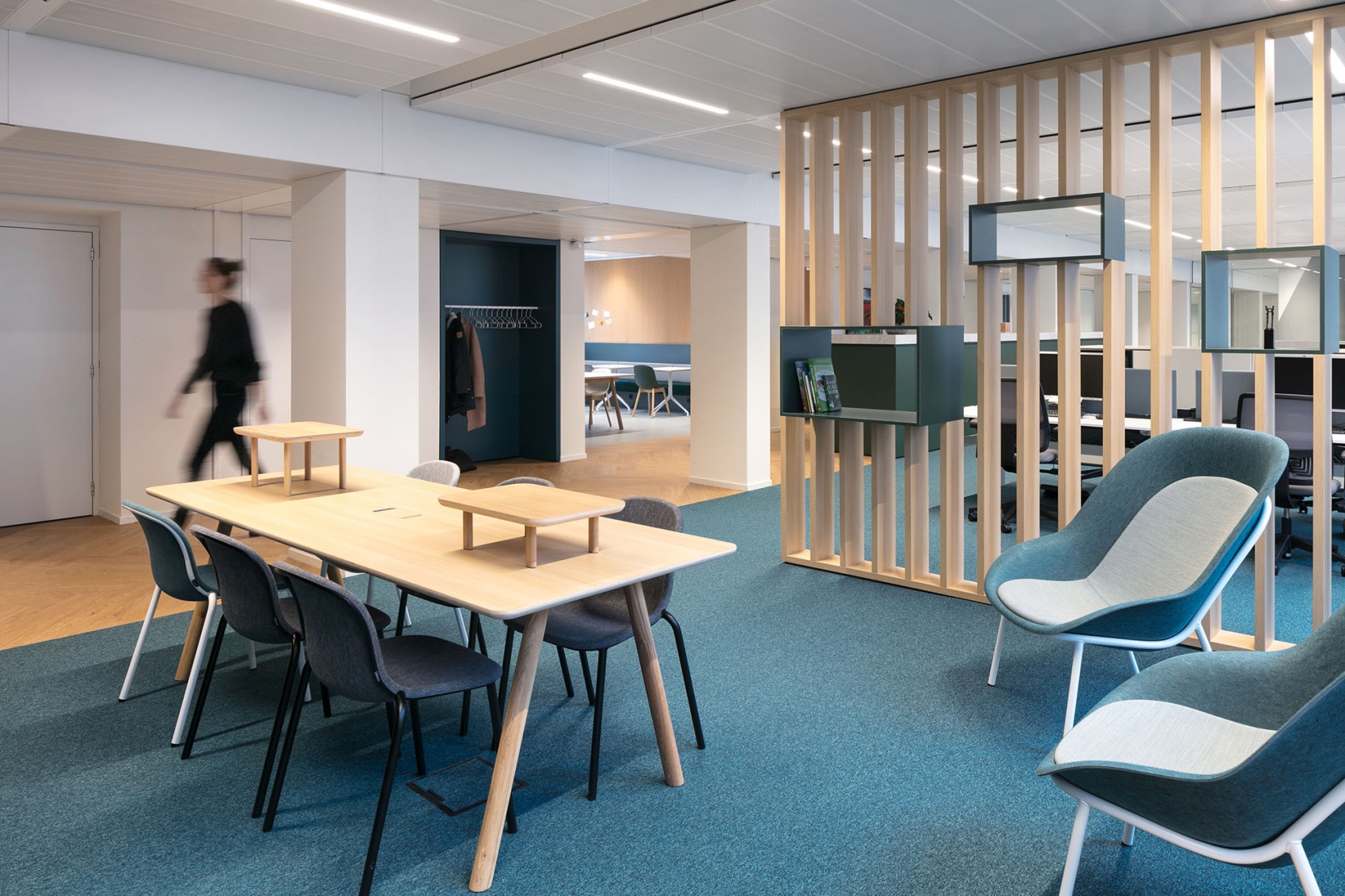
Another factor to consider for detail-driven jobs is consistency - the change of visual scenery is said to lower the concentration and cause more faults. In this case, it is advisable to keep the same colour scheme throughout all working zones.
To date, there is no unanimous opinion as per the impact of colour on employee productivity, which is understandable. Working processes are so complex that it’s simply impossible to track whether a drop or increase in efficiency was caused by visual stimuli or other factors. However, there’s a consensus that colourful workplaces tends to enhance performance more than a workplace with an achromatic scheme. For instance, a balance between cold and warm colours in the design shows a positive impact on team productivity.
So, does office colour matter?
Yes! But it’s not the only factor to consider when designing a workplace. Every office is a blend of different personalities and tastes, that have to be thoroughly studied to match the design with their needs. Colour is a primary instrument in this process, but not the only one. The level of its influence is not equally significant for everyone. People with high screening abilities are more affected by the visual stimuli, while low-screeners don’t consider colour setting to be that crucial.
If you are designing a new workplace, it would be interesting to keep Angela Wright’s research in mind. Define which personalities will be using the space and adjust your colour scheme accordingly. Creating a fit-for-all interior poses a challenge for employers and architects. The ultimate goal is a universal design with maximum flexibility, that can be tailored to individual preferences. Workplace aesthetics should not compromise its comfort - and colour choice is no exception here.
Providing a safe work environment for a diverse workforce
With the introduction of women in the office in the 1960s, things started to change. For the better, we might add. Whilst Mad Men is a great show, Sterling Cooper wasn’t a great place to work if you were a woman, person of colour or gay. We’ve come a long way since then and now diversity is high on everybody’s priority list.

Traditionally, office design is based on the company’s personality and the corporate identity is often reflected everywhere. However, times are changing and the contemporary office environment is undergoing a revolutionary change.
Today’s field of work is about connecting employees who are increasingly working remotely or flexibly. Along with the adoption of new technologies, this has caused significant changes to the meaning of teamwork. Today, the majority of employers consider diversity and inclusion to be an indispensable part of the workforce. Diversity and inclusion encourage creative and innovative thinking in businesses. Also, studies show that the right balance between focus and collaboration can lead to greater innovation and higher performance overall. The role of the architect in designing the workspace to accommodate all of this has never been so challenging.
The working environment should resonate with the people who actually work there. It’s important to take the kind of work into account, and the kind of working styles and personalities of the individuals. This doesn’t mean that you need tailor-made solutions for each employee, but it also doesn’t mean that you can assume a ‘’one size fits all’’ in the office design process. Analysing and identifying the major personality types within a company can go a long way in designing suitable workspaces.
Extraverts at work
Extraverts like to surround themselves with other people. These people are mostly full of energy and their approach is active. They value a social life and they intend to perform very well in a vibrant office space.
Introverts at work
Introverts are motivated by spending time alone. These people generally lose energy when being socially hyperactive — which by the way doesn't mean they can’t work with colleagues. They just need to recharge every now and then.
As today's open-plan offices are well suited for extrovert workers, it's important to think of the variety of workspaces. Unlike extraverts, introverts do not come into their own here. An open office environment would detrimentally affect their performance.
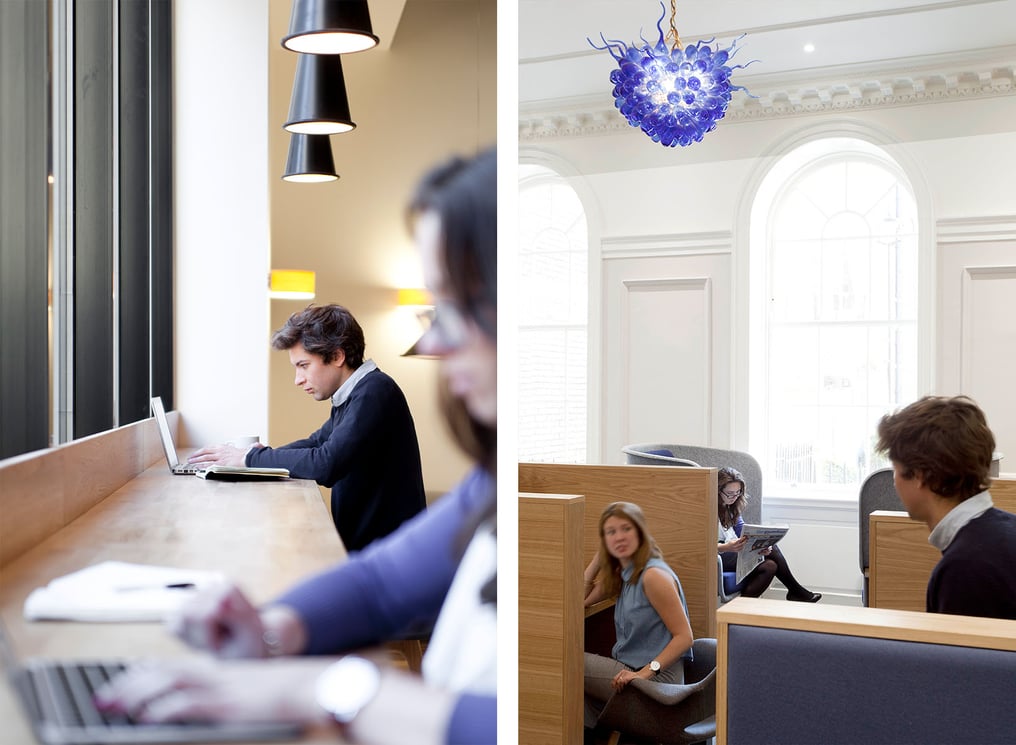
Designing workspaces for introverts, extraverts and conscientious types
So, after researching the workplace, the extent to which workers meet the criteria for both extrovert versus introvert personalities will be used by an interior architect to create an intelligent workplace. The following tips can help strike the right balance for the personalities of employees and the focus-collaboration balance they need to innovate and perform.
Introverts are more sensitive to external stimuli and working in large, collaborative groups can be tiring for them. So why not provide a few smaller acoustic meeting rooms or areas in the open workspace? Look for ways to optimize and control sound with acoustic panels, ceilings and/or partitions. By facilitating a variety of spaces, introverted workers can switch to private workplaces.
Extraverted workers are known to be more sensitive to visual distractions. As they often perform best in an open workspace, it's recommended to design this space in an inspiring but somewhat neutral way.
Conscientious types appear to be more aware of their personal space than others. For these workers, a silent workspace is required. Especially when their tasks demand uninterrupted focus, there should be an option to withdraw. This also applies to the introverted type, as they are motivated by spending time alone. Think of privacy screens, nooks and sheltered cubes in the office design!
For people who are open to experience, there should be room for visual and creative work. While extraverts tend to get distracted by lots of visuals, creative types likely perform in a space with white/mood boards, colours, and long galley desks.
Designing great breakout areas
With people spending a third of their life in the office, it becomes more than just a place of work. It’s also where we socialize, create and have fun. And it doesn’t only happen at our desk. Which is why every office needs breakout areas to serve all our purposes in our everyday work routine.
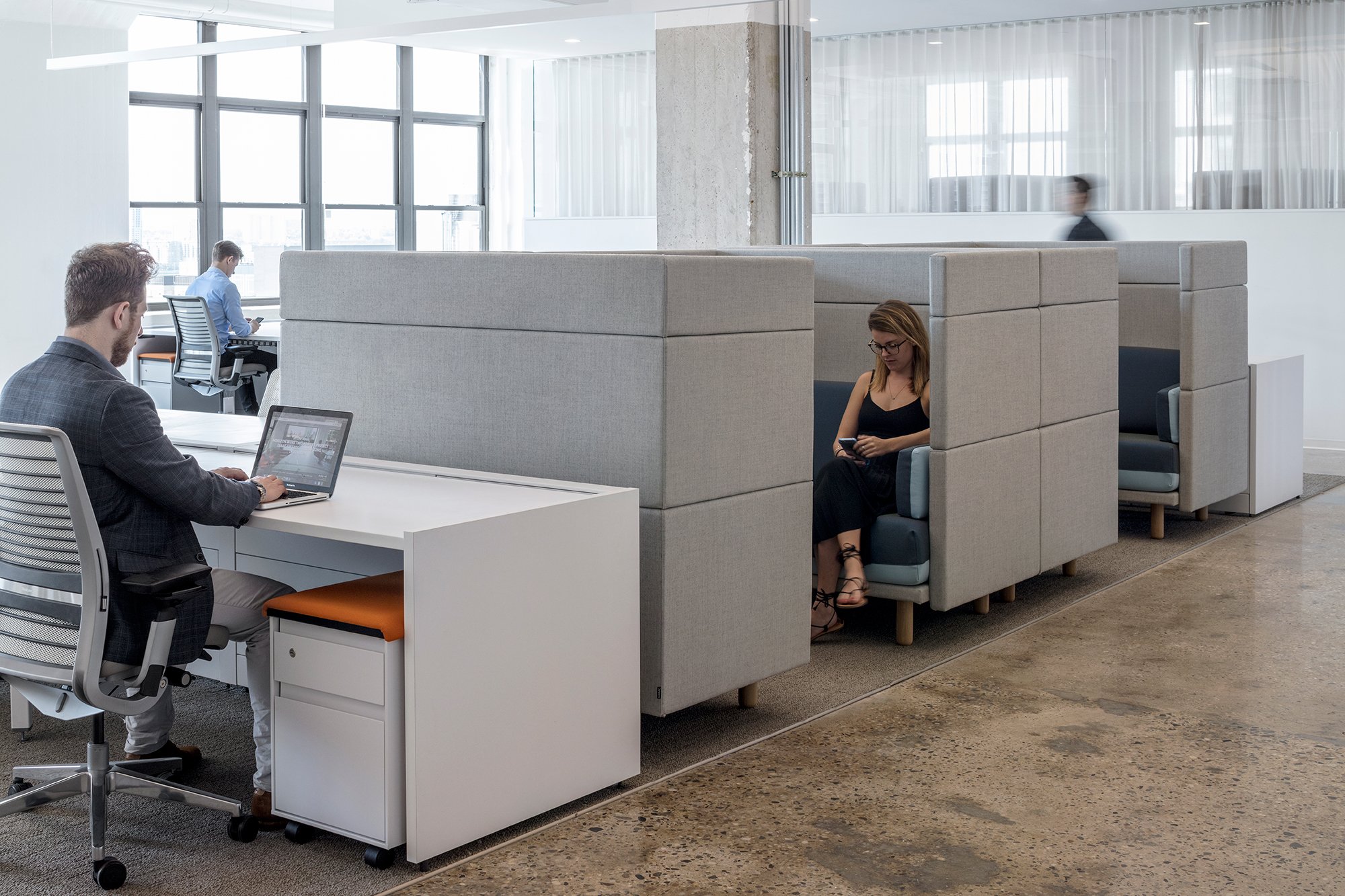
According to sociologist Ray Oldenburg, in addition to the first place, being home, and the second place being work, people desperately need a third place to fulfil their social needs, to build relations, exchange ideas and simply have a good time., Previously known as coffee shops and libraries, third places are now merging into our working worlds as well. As we spend more of our lives at work, our need for these third places are increasing and it's becoming a significant factor in the well being of employees.
Designing the office breakout area
When designing a third-place, first decide what purpose it will serve. If you have multiple purposes you’ll probably need multiple breakout areas. A quiet reading corner cannot be a game room at the same time. Maybe, your team isn’t even fond of games. So what exactly do they need? The best way to find out is to ask them - this is exactly what Hubble HQ did. They found that a kitchen, onsite gym and an office bar with drinks and snacks are among the most wanted facilities. Other preferences included individual pods, nap rooms, private meeting rooms and a swimming pool.
Don’t limit yourself to the inside area only - an outdoor garden or a rooftop terrace can also be used to create the third place. Up to 86% of workers indicated the desire to work outside, so why not let them? This could have significant long term benefits — studies show that spending a part of the working day outdoors has a positive impact on employees’ concentration, creativity and problem-solving.
The future of workplace design
As society continues to rapidly evolve so does our awareness of our increasingly complex needs within our workspaces. It is clear that the ‘’one size fits all’’ office design approach is no longer valid, neither is providing individualised tailor-made solutions. What remains is a challenge.
The challenge for interior architects is to create intelligent and flexible workplace designs that incorporate these evolving complex needs on individual and collective levels. Not only to maximise productivity, efficiency, resilience, flexibility and creativity for the company but also the needs of privacy, collaboration, individuality, well-being and personal happiness for the individual employee. The ultimate goal is a universal design with maximum flexibility, that can be tailored to individual preferences.

